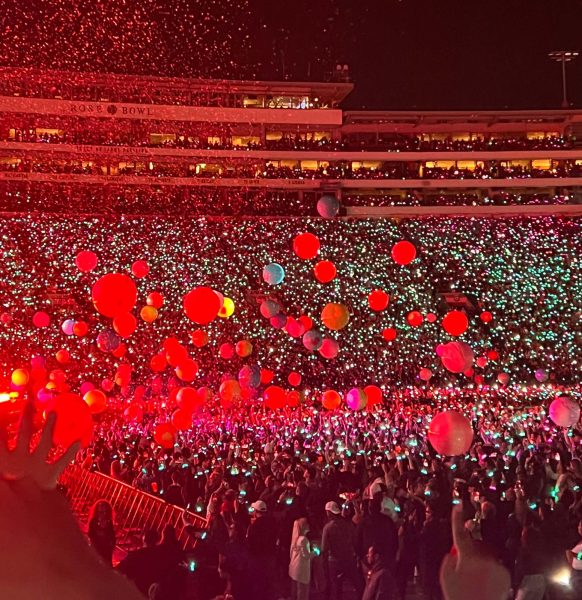
Who brings a wheel of cheese to a concert? And who throws it at the performers? Well, certain fans do. From funny signs to BeReals, fans are interacting more and more with artists during concerts, and these interactions are becoming more and more hostile. First Ava Max gets slapped onstage by a fan, then Kelsea Ballerini gets hit in the head by an object. When will it end?
Like all entertainment, concerts come with pros and cons. Dr. Juli James, Director of Community life, considers them to be a surreal experience.
“I think live music is much more interesting than listening to it on your phone or to stream. Just the sound, it’s amazing,” Dr. James said.
Dr. James was awed when she went to the Coldplay concert last September.
“It is like a love fest. There is a palpable energy with the fans [and the band], and again you feel like your presence is important and you matter in that arena,” Dr. James said.
Dr. James’ experience at the Rose Bowl was positive and safe. However, fans who attended Travis Scott’s Astroworld and Taylor Swift’s Eras Tour show in Brazil experienced otherwise.
Rapper Travis Scott’s self-organized “Astroworld” show became one of the most infamous concerts of this decade. Due to lack of security, medical care, awareness and preparation, 10 people died and more than four thousand people were injured.
At the Astroworld concert there was no assigned seating, only a standing room known as a “pit.” This is where fans were suffocated or trampled.
Kiana Morinaga ‘27 experienced a dangerous pit at a concert of the rapper Lil Yachty.
“One minute I’m enjoying myself waiting for Lil Yachty to come out and the next moment, all of a sudden, people start going forward. To avoid getting trampled on, I also moved forward because there was not really much space for me to move at all. Then he [Lil Yachty] comes out and then there’s a mosh pit and I think that was one of the worst moments I’ve had in my life. People were pushing against me and rubbing against me, people taller than me had their elbows to my neck, and I could feel walls closing in on me,” Morinanga said.
While standing in the pit can be dangerous and life threatening, so can trying leave it.
“Trying to get out… wasn’t very easy … because people just kept pushing forward, and in the midst of everything, I also lost my friends who were in the pit with me,” Morinaga said.
When Morinaga finally exited the pit she was so scared that she “started bawling” over the overwhelming horror of her situation.
When Taylor Swift performed her Eras Tour show in Brazil this fall, a fan named Ana Clara Benevides experienced profound dehydration and died of cardiac arrest; other fans at the show suffered from heat strokes. The Brazilian company that hosted the concert, Time for Fun, was accused of causing these incidents due to their poor preparation and lack of drinking water. The temperature was high during the show – at one point thermometers passed 106 degrees – and because it was held in an enclosed arena there was a great lack of circulation. No water was distributed to the audience, so Swift did it herself; during her performance she tossed bottles of water to her fans.
Water access has always been an outstanding issue among fans and artists. The Swift event led to changes in laws that allow fans to bring water into concerts, and other stadiums around the world are starting to accommodate the needs of fans and audiences.
As more incidents like these occur, people are forming mixed opinions regarding the performing artist’s responsibility.
“I do [think that it is the artist’s responsibility]. I was impressed with Taylor Swift who canceled one of her concerts because one of [her] fans died. I think that it was very cool that she did that,” Dr. James said.
Morinaga disagrees with Dr. James.
“I don’t think we should blame artists for injuries and deaths completely. I feel like we should hold the crowd more accountable because they’re the reason why injuries and such happen. [The performers/artists are] only responsible if they do see and know what’s going on,” Morinaga said.
Emma Ancu ‘25 also believes that the artist does not have as much responsibility as the crowd for keeping the event safe.
“I don’t blame the artist. I don’t think any artist, whether it’s for selfish or non-selfish reasons, wants any fans to get hurt under their name,” Ancu said.
The counter-argument to incidents like Astroworld and others like them is that violence and deaths are the fault of the crowd. While this doesn’t apply to all concerts, many crowds alike have been becoming more hostile and aggressive. According to some Tologs, unwritten behavioral rules otherwise known as concert etiquette are slowly being lost in today’s concert culture.
“I [also] think that people getting greedy at concerts ties into concert etiquette,” Ancu said.
The eagerness of fans to get the absolute best view and chance to have an interaction with an artist drives them to lose aspects of humility and respect for others around them.
“I was at a concert where I caught a tambourine and the guy next to me, who is probably 50 years old, ripped it out of my hands and caused my hands to get all cut up,” Ancu said.
Ancu also maintains that the lack of concert etiquette causes stress not just on the crowd, but the artist, stadium, security and people running the show.
“Things like that, where people get greedy and only think about themselves, make the concert less enjoyable for everybody around,” Ancu said.
The excitement of the show can lead fans to lose sense of reality, and some don’t realize the consequences of their actions.
Meanwhile, there are many artists encouraging audience members to throw things on stage. Drake, for example, regularly invites fans to toss their bras at him.
Fans are inspired to make gifts for artists and throw them on stage in hopes of getting recognized by the performer, making the concert memorable for fans.
“I was also next to a girl once who threw a whole deck of cards she made with the artist on them on the stage, and recently a photo surfaced of the artist’s tech box with one of the cards taped to it,” Ancu said.
Not all interactions between artists and fans are fun and charming. Some are bizarre and disrespectful. Last summer, for example, an audience member threw a drink at the rapper Cardi B and a fan handed a bag of their mother’s ashes to the singer Pink.
“I kind of find it disrespectful but I think that it depends on the artist. If they allow things like that to happen then that’s their decision because clearly Drake was having fun with the certain things being thrown on stage,” Morinaga said.
“Of course, [throwing things on stage] is totally disrespectful. It’s outrageous what’s happened lately.” Dr. James said. Dr. James also added that she personally has never seen someone throw something on stage due to the older demographic crowds of concerts she attends.
Another infamous incident involved the performer Bebe Rexha. During a New York City show, she was hit directly in the face by a cellphone, resulting in a black eye and stitches. The fan who threw the phone, Nicolas Malvagna, was later arrested for assault. When questioned about the incident, he said he thought throwing his phone “would be funny.”
“I’ve never thrown something at the stage and I don’t think I ever will. [But]as long as it doesn’t hurt the artist or other people around… I see no problem,” Morinaga added.
Ancu also agrees with Morinaga.
“I think that when it comes to throwing things on stage it’s all about the artist. Some artists find it disrespectful while others love the interaction. I think it’s really cool to throw things on stage personally, but if the artist doesn’t like that stuff then just don’t do it,” Ancu said.
As more artists are going on tour, like Olivia Rodrigo and Madonna, it is important to realize the varied experiences of ticket buyers, and how Tologs can prevent dangerous situations.
Some Tologs on the Hill might have different experiences attending concerts due to their gender identity, whether it is vulnerability to danger or being hyper aware of surroundings.
“As a woman I do think I have a different experience than men do at concerts. If you were to put only women in a concert it would be very tame even if it’s a mosh pit type show. However, with some guys in the crowd, they really don’t care about anyone but jumping around causing a ruckus,” Morinaga said.
Morinaga explains that men have more fun than women, not because they haven’t nothing to worry about, but because “they don’t have as many things to worry about as women do.”
Emma’s beliefs are similar to Morinaga.
“I do think as a woman you have a different experience. It could be good or bad. Artists prefer to interact with female fans. Like when they throw a drum stick into the crowd they will search for a woman rather than a man. However, I do think it can also be a worse experience,” Ancu said.
Ancu further explains the bad side of attending concerts using some of her own personal experiences. She recalls being looked at in a weird and creepy way and even being “touched inappropriately” by someone passing by.
However, Ancu believes that different experiences will happen depending on the type of crowd and concert.
On the contrary, Dr. James says she has never personally felt endangered during a concert.
“My husband and my son, who is a male, and myself have always had the same outlook and experience. But again, I don’t go to concerts where I feel unsafe and I don’t know concerts that give that off,” Dr. James said.
When attending concerts, it’s important for fans to know the kind of crowd that usually attends certain types of concerts. A crowd at a heavy metal concert can be completely different from a crowd at a folk show. Certain crowds can decide the safety of fans as seen through the Astroworld incidents to the story Kiana Morinaga told.
Tologs should be aware and informed about concerts they attend and look out for their safety. When attending concerts, it is important to not only be aware of your surroundings, but also be aware of how you might affect others at concerts. As concert culture changes, attendees can still exhibit concert etiquette while having a good time. After all, concerts are meant to be fun.
“We’re all there to have a good time so we should be mindful of how our actions could affect others,” Kiana Morinaga adds. “It’s really that simple but some think it’s the hardest thing to do.”

